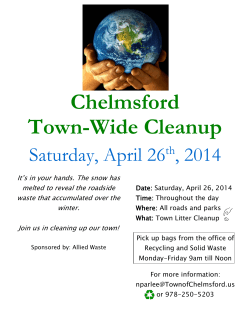
Understanding the Role of Resource Limitation in Restoration of
Understanding the Role of Resource Limitation in Restoration of Sagebrush Ecosystems Invaded by Cheagrass (Bromus tectorum L.) Jeanne Chambers, Rachel Jones, Dave Board, Dale Johnson, and Bob Blank WHY LIMIT RESOURCES? Common disturbances - removal of native species and fire - increase resources Cheatgrass is highly responsive to N availability o Early germination, higher growth and reproductive rates than natives Native perennial species are more tolerant of resource limiting conditions N reduction may decrease competitive from invaders & benefits natives Seeds of natives & conditions for establishment required EFFECTS OF FIRE ON NITROGEN Surface inorganic - N 20 a Kg ha -1 ab 15 abc 10 cde 5 de cd bc de 0 2001 2002 de e 2003 2004 2005 Available N increased from ~ 17 lbs/ac to 80-100 lbs/ac for 3 years (Rau et al. 2007, also Stubbs & Pyke 2005) EFFECTS OF PERENNIAL GRASSES & FORBS R2 = 0.15*** R2=0.49**** R2=0.39**** Perennial Native Herbaceous Cover in Year 0 (%) (Chambers et al. 2014) 1.4 1.2 1.0 0.8 0.6 0.4 0.2 0.0 2003 Undershrub Interspace Increase in biomass and seeds ~ Removal – 2 to 3 fold Burning – 2 to 6 fold Removal + Burning –10 to 30 fold Burn Control Burn Control Burn Control 6400' 7180' 7800' (Chambers et al. 2007) 5 0% 10 0%% 50 0% 10 0%% 50 0% 10 0%% 50 0% 10 0%% 50 0% 10 180 160 140 120 100 80 60 40 20 0 2002 0%% 50 0% 10 0%% 50 0% 10 0%% 50 0% 10 0%% 50 0% 10 0%% 50 0% 10 0%% 50 0% 10 No. Seeds/Plant Biomass/plant (g) CUMULATIVE EFFECTS OF FIRE & REMOVAL Burn Control Burn Control B 6400' 7180' APPROACHES FOR LIMITING RESOURCES Direct manipulation of soil resources o Carbon amendments Encourage population growth of soil microbes to tie up soil N o Repeated burning Immediate N pulse due to SOM denaturation, uptake by plants, volatilizing N in soils & biomass causing progressive N deficiency Litter removal o Modulate soil temperature and moisture increasing SOM decomposition and its removal decreases soil N availability o Decrease seed bank & provide less favorable environment for establishment Seeding competitors with similar phenology o Decrease resource availability (water, N, light) EXPERIMENT #1 – RESOURCE AND PROPAGULE AVAILABILITY How do resource availability (inorganic N) and propagule availability influence establishment of cheatgrass and native perennial species? Wyoming big sagebrush/Sandbergs bluegrass dominated by cheatgrass, 4600 ft elevation, 9-11 in precipitation Carbon addition - 150 g C m2 sucrose or none Different seeding densities o B. tectorum (0, 150, 300, 600, and 1,200 viable seeds m2) o Native species (0, 150, 300, and 600 viable seeds m2) Shrub - Artemisia tridentata ssp. wyomingensis Forbs - Achillea lanulosa, Sphaeralcea grossularifolia Grasses- Poa secunda, Elymus multisetus, Pseudoroegneria spicata Repeated in two years EFFECTS OF SUCROSE ADDITION Short-term effects on available N Higher NO3- in winter months Repeated applications necessary for longer term effects (Mazzola et al. 2010, also Pashke et al. 2000, Blumenthal et al. 2003, Blank and Young 2009) EFFECTS OF SUCROSE ADDITION & CHEATGRASS SEEDING DENSITY Negative effect of sucrose on cheagrass density, biomass & seed production Positive effect of seeding density Cheat density not affected by native seeding rate (Mazzola et al. 2010) EFFECTS OF SUCROSE ADDITION & CHEATGRASS SEEDING DENSITY Little to no effect of sucrose on native density & growth Negative effect of cheatgrass seeding density EFFECTS OF NATIVE SEEDING DENSITY Positive effect of native seeding density on establishment only in first year Reaffirms importance of seedling life stage Common seeding rates are 150 to 300 seeds m2 – 2 to 3 times that may be required (Mazzola et al. 2010; also Sheley et al. 2006) EXPERIMENT #2 – DIRECT AND INDIRECT RESOURCE MANIPULATION How do restoration treatments to reduce resources (repeated burning, litter manipulation, seeding an annual competitor) affect soil N availability & cheatgrass success? Wyoming big sagebrush/Sandbergs bluegrass dominated by cheatgrass, 4600 m elevation, 9-11 in precipitation Litter intact and litter removed experiments Repeated burning and seeding treatments nested within litter Not burned and not seeded (N) Burned and not seeded (B) Burned and seeded with cheatgrass (C) Burned and seeded with wheat (W) Burning repeated over 4 years at 2 sites EFFECTS ON AVAILABLE SOIL N Available N did not decrease over time - soil temperatures were too cool to volatilize soil OM Available N was lower on unburned than burned plots regardless of treatment EFFECTS ON LITTER Litter biomass (g m-2) 1200 1000 Litter removed plots Litter intact plots 1200 Litter intact, unburned Litter intact, burned only Litter intact, burned and seeded with cheatgrass cheatgras Litter intact, burned and seeded with wheat 1000 800 800 a 600 a b b b 400 200 a b b b 0 2008 2009 2010 600 Litter intact, unburned Litter removed, unburned Litter removed, burned only Litter removed, burned and seeded with cheatgrass cheatgrass Litter removed, burned and seeded with wheat a a a 400 a ab b b 2011 b b b 2012 Burning caused 30 to 50% litter loss each year (Jones et al. 2014, in press) 200 0 b b b b b b b b 2009 2010 a b bc bc c 2011 b c c c 2012 EFFECTS ON CHEATGRASS BIOMASS Cheat biomass, & seed production tracked N availability over time Litter removal decreased biomass & density Plots burned and seeded with wheat had consistently lower biomass, density, seeds PUTTING IT ALL TOGETHER PUTTING IT ALL TOGETHER PUTTING IT ALL TOGETHER PUTTING IT ALL TOGETHER IMPORTANCE FOR RESTORATION Integrated restoration approaches to limit resources & decrease cheatgrass establishment may be more effective than manipulating soil N directly Carbon amendments reduce N and limit cheatgrass while allowing native establishment but have short term effects Repeated burning does not decrease available soil N due to cool burn temperatures and does not directly affect cheatgrass Litter removal decreases cheatgrass density, biomass and seed production Seeding a competitor with similar growth characteristics is highly effective in reducing cheatgrass success Higher seeding rates or more effective planting methods of natives may be required Weather determines outcomes & multiple interventions may be needed The preceding presentation was delivered at the 2015 National Native Seed Conference Santa Fe, New Mexico April 13-16, 2015 This and additional presentations available at http://nativeseed.info
© Copyright 2025









